Drum Screen
A Hubert drum screen is designed to filter very large flow rates in a water intake
A Hubert drum screen is a rotating (secondary) filtration system used in a fresh or sea water intake. This machine is self-cleaning fully automatic screen suitable to filter very large flow rates at a relatively fine filtration degree.
Every project location is different. As a result, excavating and civil engineering cost vary from site to site and have a important influence on the choice of screening system.
Compared to travelling band screens, drum screens can rotate faster and consequently able to handle more debris. In addition, these screens can often manage with shallower pits.
Hubert supplies its own designs where possible, however all systems are engineered as per your project specifications. If you prefer a different design, we can of course also supply this. We are happy to advise you to make the best choice for your project. When renovating existing installations (which have been in operation for many years), (dated) designs are often used or, if possible, the civil construction is adapted to a modern design.
Part of the design is also a vertical or horizontal arrangement: vertical drum screens are common at seawater intakes in combination with very large water flows, horizontal drum screens are often used for microfiltration during fresh water intake.
With a horizontal drum screen, the dirt is discharged through the main shaft and the filter lies in an enclosed pit or tank. With a vertical drum screen, dirt discharge takes place at the periphery of the filter at deck level.
Below you will find an explanation of frequent applied drum screens.
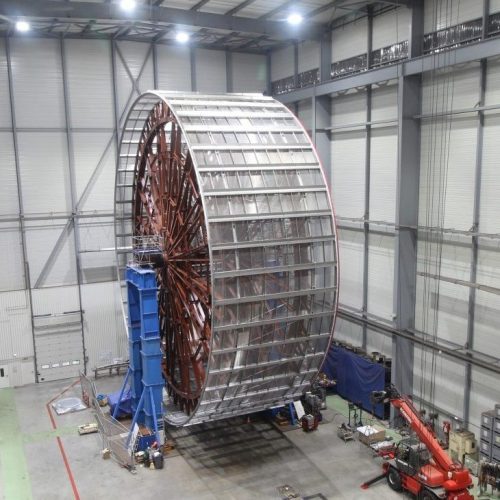
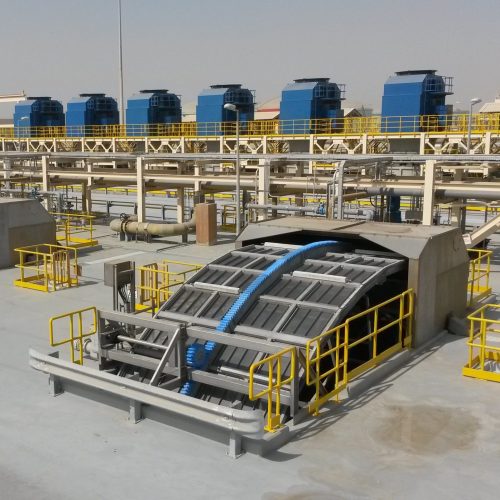
Hubert – Water Intake Systems
Hubert – specialist in water intake systems for cooling, drinking and process water
Hubert is market leader in water intake screening systems. These systems can be found in power stations, petrochemical plants and refineries, desalination plants, drinking water and irrigation plants and industrial production plants requiring a huge demand of process water. We supply complete complete ‘screening trains’ including all additional equipment, like controls and cathodic protection. We design, engineering and manufacure our equipment in-house. This movie includes an animation of a typical water intake, showing the water flow from the suction from the sea to the arrival at the pumps.
You will find our projects in both new construction (EPC) projects and renovation and optimization of existing water intakes.
Water intake systems are used for mechanically clean water extracted from the sea, rivers or lakes. See also Markets and Applications.
Hubert – Water Intake Systems
Hubert – specialist in water intake systems for cooling, drinking and process water
Hubert is market leader in water intake screening systems. These systems can be found in power stations, petrochemical plants & refineries, desalination plants, drinking water & irrigation plants and industrial production plants requiring a huge demand of process water. We supply complete complete ‘screening trains’ including all additional equipment, like controls and cathodic protection. We design, engineering and manufacure our equipment in-house. This movie includes an animation of a typical water intake, showing the water flow from the suction from the sea to the arrival at the pumps.
You will find our projects in both new construction (EPC) projects and renovation & optimization of existing water intakes.
Water intake systems are used for mechanically clean water extracted from the sea, rivers or lakes. See also Markets & Applications.
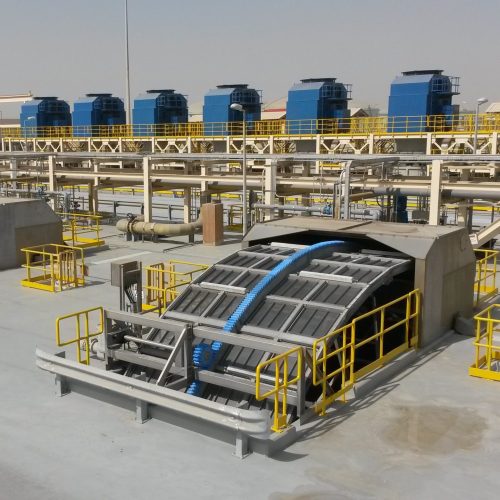
Typical Layout of a Drum Screen
Vertical drum screen assembly for EDF’s nuclear power plant Flamanville 1 & 2 in France
This movie shows drum screen applied for a seawater intake.
Vertical Drum Screen
A Hubert vertical drum screen is the ‘heart’ of the ‘screening train’
A Hubert (vertical) rotary drum screen is mainly used used for (sea)water intakes as part of power plants and desalination plants, where tidal differences can also play a role. Our definition of vertical drum screen implies that debris discharge takes place at the periphery of the filter at deck level.
A drum screen is typically installed in water intake systems downstream from coarse bar screens.
Regularly occurring flow rates are between 40.000 and 120.000 m3/h per screen, depending on customer requirements and the local situation at the intake. Woven mesh with a diameter of about 2-3 mm is used as filter medium. This movie gives an impression of a vertical drum screen during assembly.
Horizontal (Micro) Drum Screen
Hubert micro screen: potable water production & proces water recirculation
A Hubert horizontal rotary micro screen, micro drum screen or micro strainer, is often used in places where high demands are required on the purity of process water. This type of drum screen is called micro screen because the filtration degree is less than 1 mm. These filters can be found in (fresh) water intakes, acting as (fine) pre-filtration system being part of potable water production plants or production plants that consume a lot of process water. Our definition of horizontal drum screen implies that debris is discharged through the main shaft and the filter lies in an enclosed pit or tank.
In addition, this filter can be also applied for process water recirculation. The recovery of useful raw materials from process water, stricter discharge requirements, recycling of process water, etc. makes the use of these engineered filters increasingly interesting. Another pre-treatment of influent & effluent in a waste water treatment plant.
Flow rates can be up to 5000 m3/h per screen, depending on customer requirements and the local situation at the intake. Woven mesh with a diameter of about 11 up to 500 micron is used as filter medium. This type of filter is usually applied under free fall conditions. The efficiency and capacity of a microstrainer in a water intake, depends on several factors including the characteristics of the fine filtration mesh (fabric), rotation speed of the microscreen, the quality of the water to be purified and the amount of backwashing water.
Vertical Drum Screen
A Hubert vertical drum screen is the ‘heart’ of the ‘screening train’
A Hubert (vertical) rotary drum screen is mainly used used for (sea)water intakes as part of power plants and desalination plants, where tidal differences can also play a role. Our definition of vertical drum screen implies that debris discharge takes place at the periphery of the filter at deck level.
A drum screen is typically installed in water intake systems downstream from coarse bar screens.
Regularly occurring flow rates are between 40.000 and 120.000 m3/h per screen, depending on customer requirements and the local situation at the intake. Woven mesh with a diameter of about 2-3 mm is used as filter medium. This movie gives an impression of a vertical drum screen during assembly.
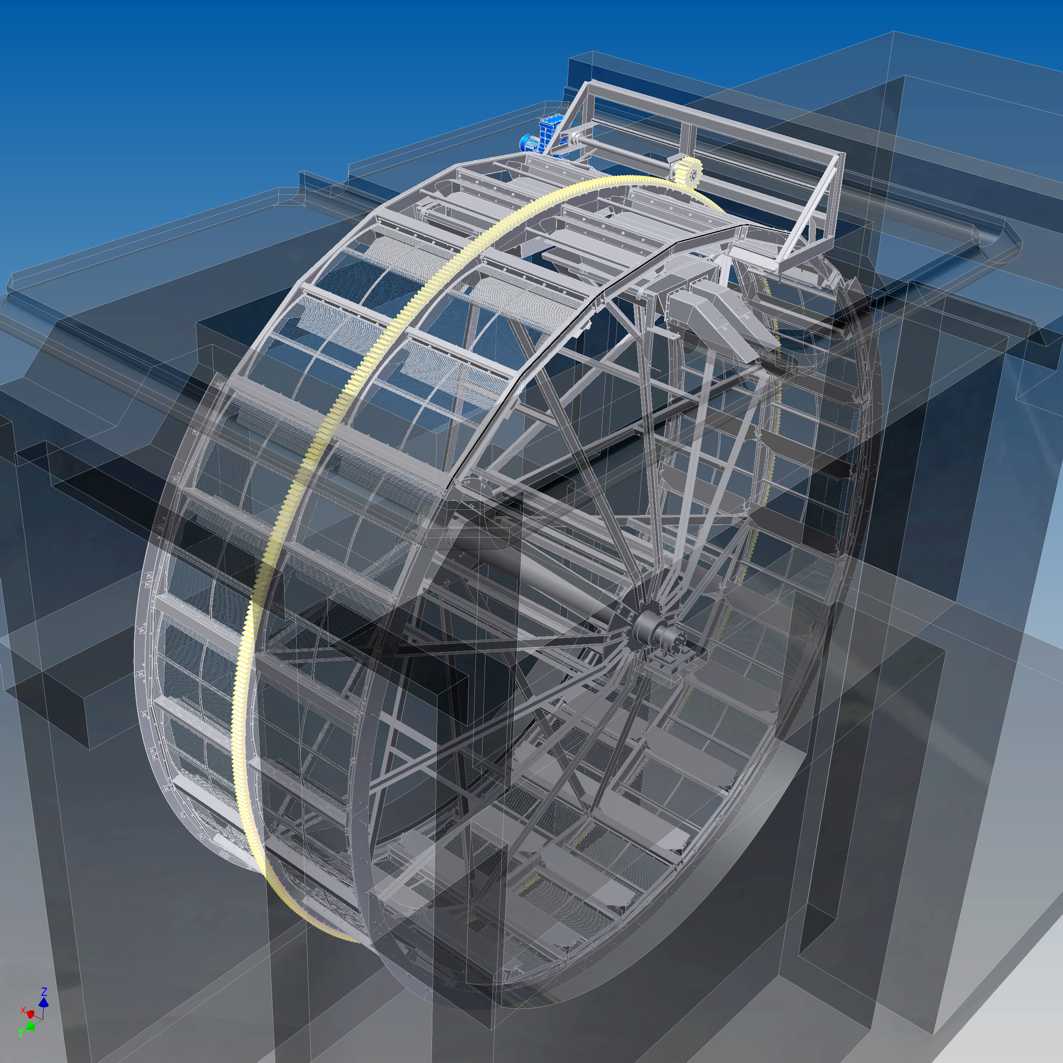
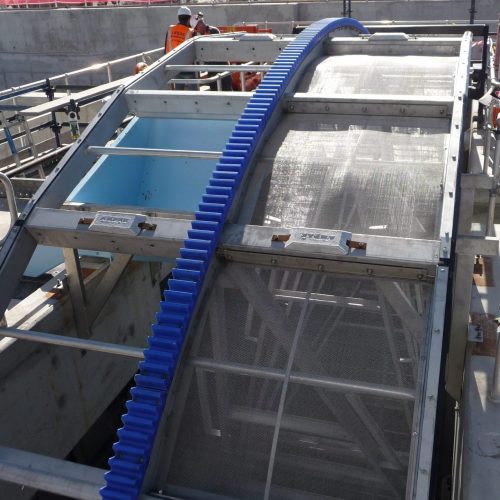
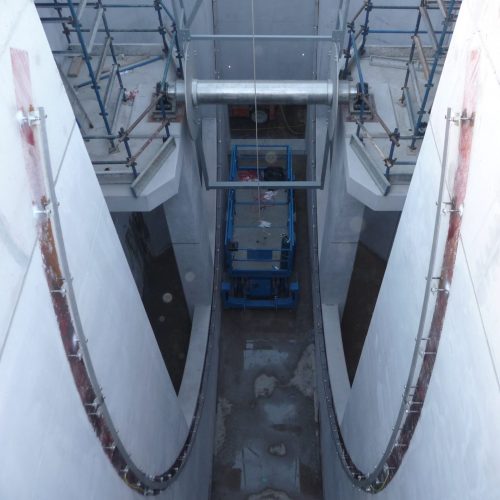
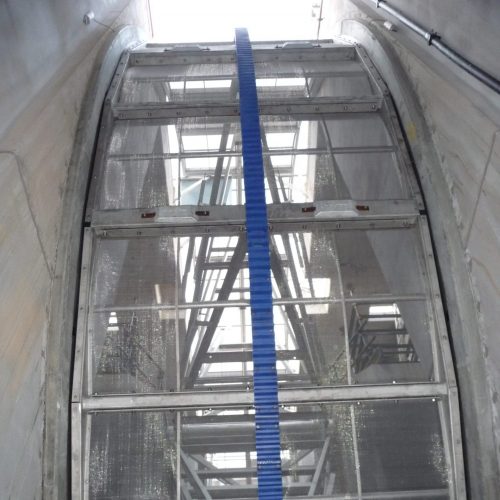
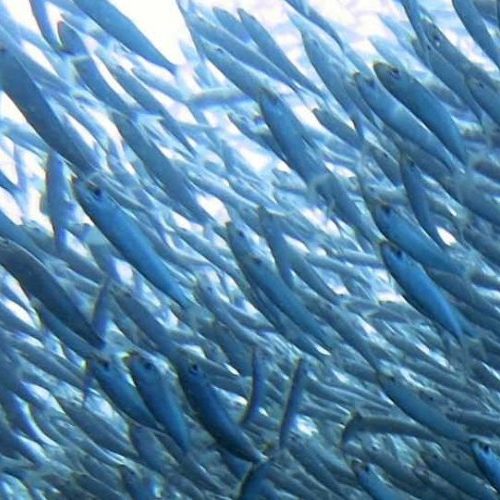
Design, Construction and Operation
The drum is placed in a concrete pit or tanks and rotates on a stationary hollow shaft. The water to be filtered flows through the drum panels and the dirt particles remain trapped in the mesh.
Hubert vertical drum screens are available for different flow patterns see further on this page, or see page Flow Patterns Drum Screen for a comparison between different flow patterns.
As the drum rotates the row of sceen panels pass under or above a set of high pressure water jets at the top of the drum. The dirt particles are washed from the screen and discharged through a debris collector system. The screens are normally not in motion and are washed periodically when clogged by debris. Permanent rotation can be provided.
The Hubert vertical (rotary) drum screens are designed with A-shaped spokes, resulting in high rigidity and resistance to deformation. This produces an accurate fit against pit walls, enabling filtration of particles down to 2 mm. All Hubert drum screens are fitted with maintenance free slide (sea)water lubricated bearings. The same applies to the ring gear and drive pinion, which are made of special wear resistant polyamide.
Fish Friendly - Fish recovery system
Hubert’s drum screens can be supplied with a fish recovery gutter or channel that allows trapped fish to be removed in a gentle and effective way. These recovery systems are tailor-made for each project.
Features and Benefits
- Large flow capacities
- The A-spoke construction results in a light stable and rigid structure
- Reliable
- Maintenance free
- Long lifetime (30 years or more)
- Resistant to abrasive water
- Debris is removed at or above deck level, eliminating the need for a debris pump
- Savings on spare parts
- (Sea) water lubricated bearing
- Spray water cleaning
- Fish removal system
Standard Dimensions and Materials
- Drum width up to 5 m
- Drum diameter up to 20 m
- Filter rating / mesh opening 2 / 10 mm
- Materials can be coated carbon steel, stainless steel, duplex and super duplex (PREN > 40)
Vertical Drumscreen – Flow Patterns
Hubert supplies both ‘Dual Flow’ and ‘Center Flow’ pattern. A ‘Dual Flow’ configuration has some advantages against ‘Center Flow’. In case of a newly built plant, Hubert advises the ‘Dual Flow’ pattern. More information about the differences and a comparison in flow patterns can be found on page Flow Patterns Drum Screen .
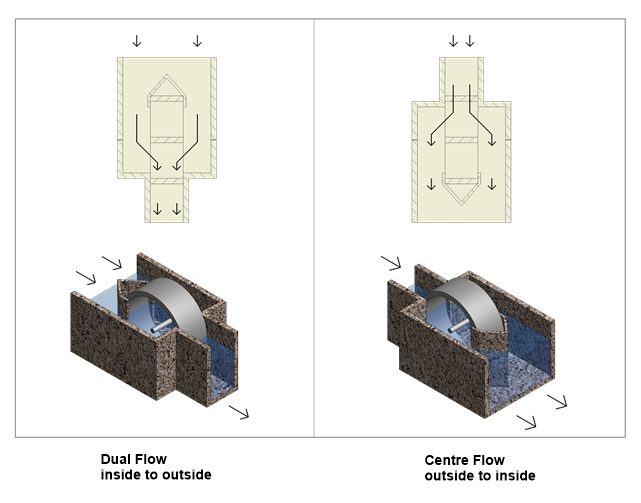
Horizontal (Micro) Drum Screen
Hubert micro screen: potable water production and process water recirculation
A Hubert horizontal rotary micro screen, micro drum screen or micro strainer, is often used in places where high demands are required on the purity of process water. This type of drum screen is called micro screen because the filtration degree ranges from 0.5~1 mm to (theoretically) 11 microns. These filters can be found in (fresh) water intakes, acting as (fine) pre-filtration system being part of potable water production plants or production plants that consume a lot of process water. Our definition of horizontal drum screen implies that debris is discharged through the main shaft and the filter lies in an enclosed pit or tank.
In addition, this filter can be also applied for process water recirculation. The recovery of useful raw materials from process water, stricter discharge requirements, recycling of process water, etc. makes the use of these engineered filters increasingly interesting. Another application is pre-treatment of influent and effluent in a waste water treatment plant.
Flow rates can be up to 5000 m3/h per screen, depending on customer requirements and the local situation at the intake. Woven mesh with a diameter of about 11 up to 500 micron is used as filter medium. This type of filter is usually applied under free fall conditions. The efficiency and capacity of a microstrainer in a water intake, depends on several factors including the characteristics of the fine filtration mesh (fabric), rotation speed of the microscreen, the quality of the water to be purified and the amount of backwashing water.
We also use perforated plate as filter medium, with a hole dia starting from 0.5~1 mm. In that case we call this type of filter a perforated (rotating) drum screen. Larger filtrations (> 1-2 mm) will be normally done by travelling band screens or larger vertical drum screens (see above) in open channels.
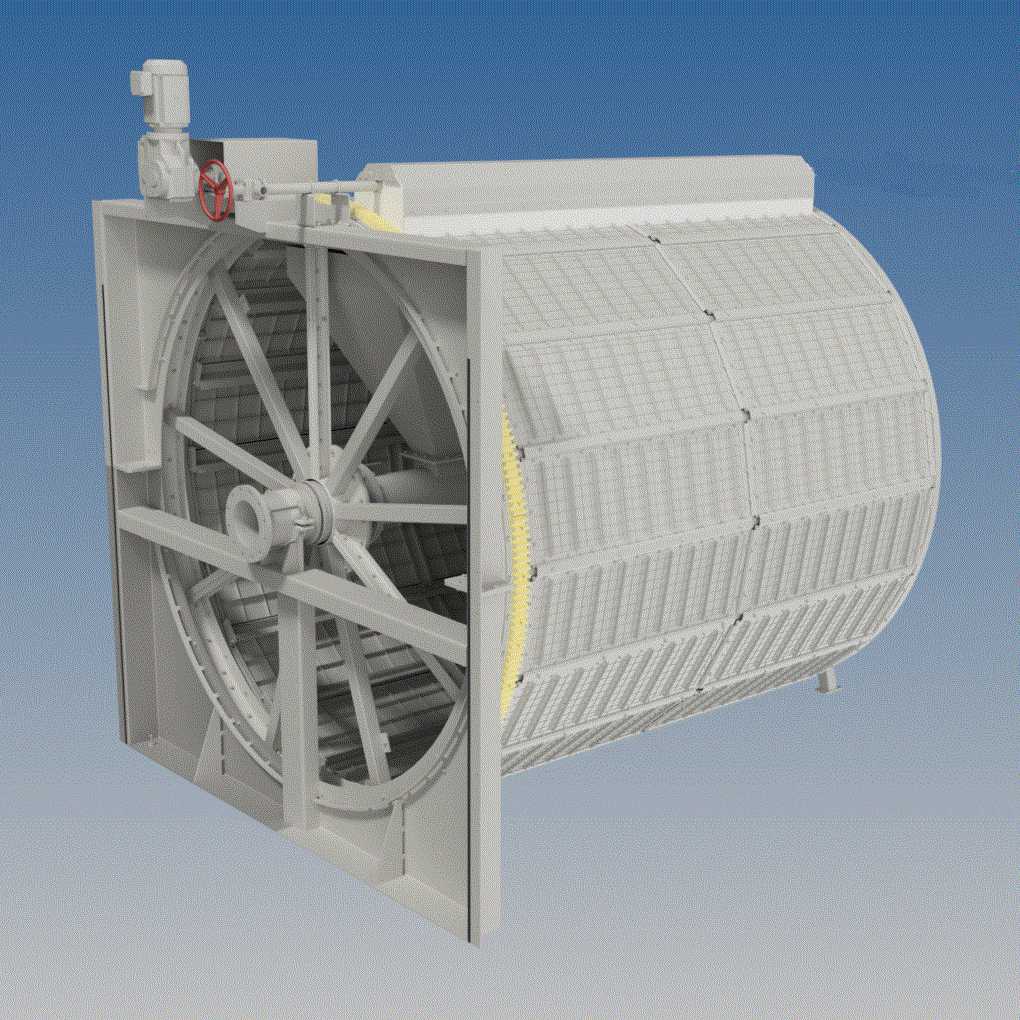
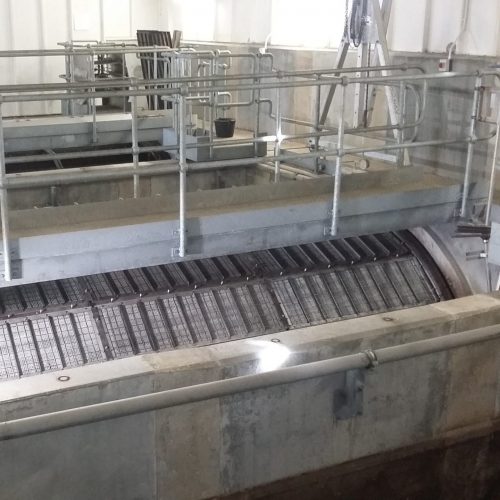

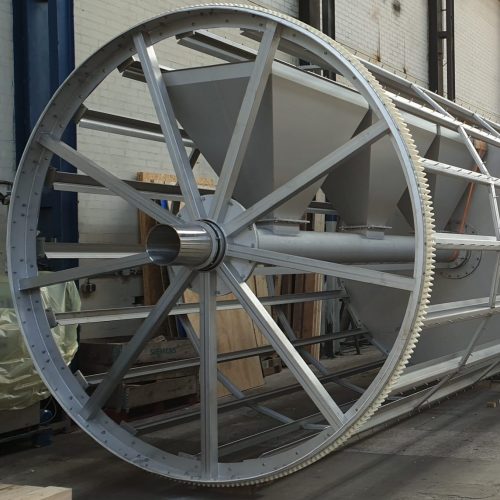

Design, Construction and Operation
The Hubert micro screen system consist of a drum fitted along its outer circumference with screen panels. The drum is placed in a concrete pit or tanks and rotates on a stationary hollow shaft fitted with one or more funnel-shaped debris collectors. The feedstock of water enters the drum axially and flows radially through the mesh panels. The dirt particles remain trapped in the mesh.
As the drum rotates the row of sceen panels pass under a set of high pressure water jets at the top of the drum. The dirt particles are washed from the screen and discharged through the funnel-shaped debris collectors and the hollow shaft.
The “clean” side of the screen compartiment is fitted with an overflow weir which enables the water inside the screening chamber to be kept at a constant level. This ensures that the largest possible screening area is constantly submerged resulting in a high yield of solids.
Fish Friendly - Fish recovery system
Als our microscreens can be provided with a fish recovery system that allows trapped fish to be removed in a gentle and effective way.
Features and Benefits
- Light, stable and robust construction
- Reliable
- Maintenance free
- Long lifetime (30 years or more)
- Resistant to abrasive water
Standard Dimensions and Materials
- Drum length up to 6 m
- Drum diameter from 0,7 up to 3,5 m
- Filter rating / mesh opening from 11 to 500 micron
- Materials can be stainless steel, duplex and super duplex (PREN > 40)
Micro Screen Explanation
This video explains how a micro screen works. This is a micro screen specially made for a pilot project to test two different mesh widths for pre-filtration at a plant.






